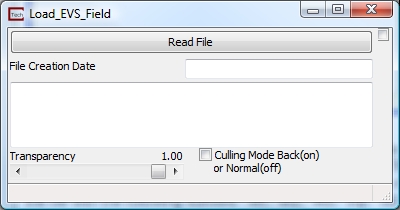![]()
General Module Function
Load_EVS_Field supplants the need for Read_UCD, Read_netCDF and Read_Field by incorporating all of their functionality and more in a single module. It reads a dataset from any of six different EVS/MVS compatible file formats into an EVS field, including the new EVS Field Formats:
1) .eff ASCII format, best if you want to be able to open the file in an editor or print it
2) .efz GNU Zip compressed ASCII, same as .eff but in a zip archive
3) .efb binary compressed format, the smallest & fastest format due to its binary form
The EVS Field Formats *.eff;*.efz;and *.efb support all types of EVS field output including:
1) Uniform fields
2) Geology (from Krig_3D_Geology and Spline_Geology)
3) Structured fields (such as irregular fields read in from Read_Field)
4) Unstructured Cell Data (UCD format) general grids with nodal and/or cell data
5) Special fields containing spheres (which are points with radii)
6) Special fields containing color data (such as from Read_DXF)
Note: Because the .eff, .efz and .efb formats better handle all types of EVS/MVS output, these three formats are recommended for use over UCD, netCDF or Field.
For a description of the .EFF file formats click here.
Module Input Ports
The Load_EVS_Field module is shown above. It has no input ports. It obtains the EVS Field input data by reading a file with a file browser.
Module Output Ports
Load_EVS_Field has three or four output ports.
If the field file being read was the output of modules like Krig_3D_Geology or Spline_Geology, there will be four output ports and the module will look like:
![]()
The first port (closest to the left) passes a string representing any notes that were found in the file. These notes exist only in field file and are not necessary for the module to run.
The second port (Brown-Grey-Light Brown-Beige) outputs geology material info similar to the same color ports on Krig_3D_Geology or Spline_Geology.
The third port outputs the mesh and data components to other modules which accept Field data types.
The fourth (red) port is used to send data directly to the viewer for rendering.
Otherwise the ports will be:
The first port (closest to the left) passes a string representing any notes that were found in the file. These notes exist only in field file and are not necessary for the module to run.
The second port outputs the mesh and data components to other modules which accept Field data types.
The third port is used to send data directly to the viewer for rendering.

Module Control Panel
The user interface for Load_EVS_Field consists of the file browser shown above, a window showing the file creation date, and any notes that were in the file. The notes are only in EVS Field files (*.eff;*.efz;*.efb) and are not necessary for the module to run. The file browser is used for selecting the file with the following suffixes *.eff;*.efz;*.efb;*.inp;*.fld; or *.cdf. Double clicking on a filename or selecting a file name and choosing OK reads the selected file into memory and closes the file browser. After the file has been read into memory, the mesh and data components are passed to any downstream modules in the application. Selecting a different file, after one has been read in, will replace the first file’s mesh and data components with the new file’s mesh and data components and all modules will be updated with the new data.
The Culling Mode toggle controls whether back facing surface are visible. Generally you will want this ON when making the object(s) transparent.
The Transparency slider determines the opacity of the objects.
Related Modules
© 1994-2018 ctech.com